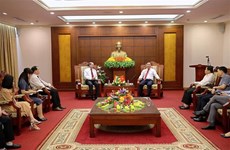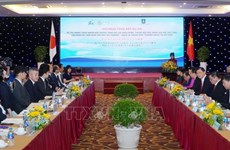EAS to involve Russia, US from 2011
The fifth East Asia Summit (EAS), which convened in Hanoi on Oct. 30,
decided to officially invite Russia and the United States to
participate in the EAS from 2011, as part of its expansion plan.
The fifth East Asia Summit (EAS), which convened in Hanoi on Oct. 30,
decided to officially invite Russia and the United States to
participate in the EAS from 2011, as part of its expansion plan.
The EAS made decision by taking into account the desire and the potential of contribution by Russia and the US to the forum.
It said Russia and US ’s participation shall be based on the respect for the EAS principles, objectives, modalities and priorities, and support for ASEAN’s major role.
The fifth EAS was chaired by Prime Minister Nguyen Tan Dung and attended by leaders of ASEAN countries, China , Japan , the Republic of Korea , Australia , New Zealand , and India .
It also saw the presence of the Russian Foreign Minister and the US Secretary of State, who represented their respective Presidents as special guests of the Chair.
Prime Minister Nguyen Tan Dung, in his opening speech, underlined that the EAS has, after five years of establishment, recorded dynamic developments and made important contributions to promoting dialogue on strategic issues for better understanding and cooperation among participating countries, toward peace, stability and prosperity in the region.
The EAS leaders reaffirmed the forum’s agreed principles, objectives and modalities and adopted the Hanoi Declaration on the Commemoration of the fifth Anniversary of East Asia Summit in which they reiterated their commitment for continued efforts to enhance dialogue and cooperation and set out direction and priority of development for the next period.
They agreed to boost cooperation in five priority areas, entailing education, finance, energy, disaster management and avian flu prevention, while exploring the possibilities of cooperation in such new areas as post-crisis recovery, sustainable development, and climate change.
The leaders of EAS participating countries expressed support for the ASEAN leaders’ Statement on Human Resources and Skills Development for Economic Recovery and Sustainable Growth, which was adopted at the 17 th ASEAN Summit, and affirmed their close coordination with ASEAN towards sustainable economic growth in the region.
The EAS countries agreed to conduct further study on the possibility of establishing the East Asia Free Trade Area (EAFTA) in parallel with the Comprehensive Economic Partnership in East Asia (CEPEA) and tasked senior officials to work on the issue and submit concrete recommendations to the leaders.
At this summit, the EAS leaders also discussed regional and international issues of mutual interest, including closer coordination and consultation to prepare for the participation and contribution of the ASEAN Chair at the upcoming G-20 Summit in Seoul , the Republic of Korea , the situation on the Korean Peninsula and the global nuclear issue.
Highlighting the EAS’s growing role in promoting dialogue and cooperation in the region, the EAS leaders committed to further step up dialogue and cooperation on broad strategic political and economic issues for peace, stability and prosperity in East Asia, including dealing with traditional and non-traditional challenges, and at the same time, support and assist the peaceful settlement of disputes on the basis of international laws.
Discussing the evolving regional architecture, the EAS leaders supported ASEAN’s view on the formation of a regional architecture based on the existing regional cooperation processes and ensuring ASEAN centrality.
They welcomed the pro-active participation and constructive contribution of external partners in dealing with emerging challenges facing the region.
At the end of the summit, the Chairman issued a Chairman’s Statement on important outcomes and decisions of the fifth EAS./.
The EAS made decision by taking into account the desire and the potential of contribution by Russia and the US to the forum.
It said Russia and US ’s participation shall be based on the respect for the EAS principles, objectives, modalities and priorities, and support for ASEAN’s major role.
The fifth EAS was chaired by Prime Minister Nguyen Tan Dung and attended by leaders of ASEAN countries, China , Japan , the Republic of Korea , Australia , New Zealand , and India .
It also saw the presence of the Russian Foreign Minister and the US Secretary of State, who represented their respective Presidents as special guests of the Chair.
Prime Minister Nguyen Tan Dung, in his opening speech, underlined that the EAS has, after five years of establishment, recorded dynamic developments and made important contributions to promoting dialogue on strategic issues for better understanding and cooperation among participating countries, toward peace, stability and prosperity in the region.
The EAS leaders reaffirmed the forum’s agreed principles, objectives and modalities and adopted the Hanoi Declaration on the Commemoration of the fifth Anniversary of East Asia Summit in which they reiterated their commitment for continued efforts to enhance dialogue and cooperation and set out direction and priority of development for the next period.
They agreed to boost cooperation in five priority areas, entailing education, finance, energy, disaster management and avian flu prevention, while exploring the possibilities of cooperation in such new areas as post-crisis recovery, sustainable development, and climate change.
The leaders of EAS participating countries expressed support for the ASEAN leaders’ Statement on Human Resources and Skills Development for Economic Recovery and Sustainable Growth, which was adopted at the 17 th ASEAN Summit, and affirmed their close coordination with ASEAN towards sustainable economic growth in the region.
The EAS countries agreed to conduct further study on the possibility of establishing the East Asia Free Trade Area (EAFTA) in parallel with the Comprehensive Economic Partnership in East Asia (CEPEA) and tasked senior officials to work on the issue and submit concrete recommendations to the leaders.
At this summit, the EAS leaders also discussed regional and international issues of mutual interest, including closer coordination and consultation to prepare for the participation and contribution of the ASEAN Chair at the upcoming G-20 Summit in Seoul , the Republic of Korea , the situation on the Korean Peninsula and the global nuclear issue.
Highlighting the EAS’s growing role in promoting dialogue and cooperation in the region, the EAS leaders committed to further step up dialogue and cooperation on broad strategic political and economic issues for peace, stability and prosperity in East Asia, including dealing with traditional and non-traditional challenges, and at the same time, support and assist the peaceful settlement of disputes on the basis of international laws.
Discussing the evolving regional architecture, the EAS leaders supported ASEAN’s view on the formation of a regional architecture based on the existing regional cooperation processes and ensuring ASEAN centrality.
They welcomed the pro-active participation and constructive contribution of external partners in dealing with emerging challenges facing the region.
At the end of the summit, the Chairman issued a Chairman’s Statement on important outcomes and decisions of the fifth EAS./.













